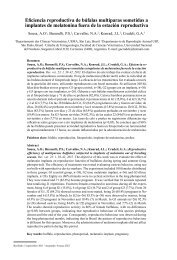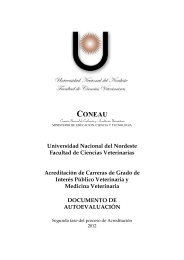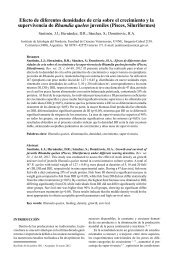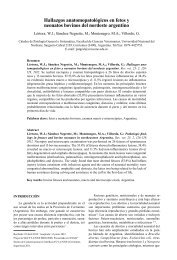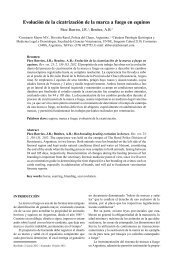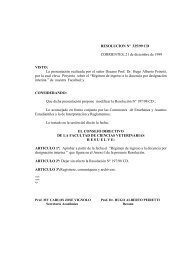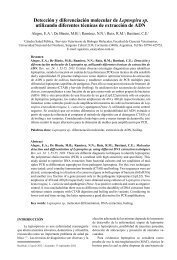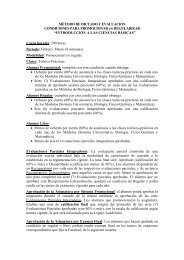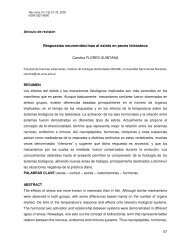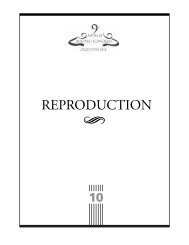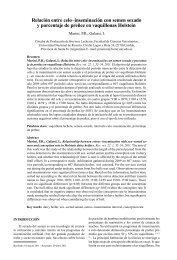MILK PRODUCTION
MILK PRODUCTION
MILK PRODUCTION
You also want an ePaper? Increase the reach of your titles
YUMPU automatically turns print PDFs into web optimized ePapers that Google loves.
566<br />
<strong>MILK</strong> <strong>PRODUCTION</strong><br />
Main morphological defects in<br />
Mediterranean Italian buffalo<br />
Coletta A. 1 , Amante L. 1 , Fezza C. 2 , Neri M. 1 , Caso C. 1<br />
1 ANASB, Via Cesare Battisti, Caserta, Italy 2 Dottore in Scienze e Tecnologie delle Produzioni Animali ed Esperto di Razza Bufala<br />
Mediterranea Italiana Corresponding author: C. Caso. ANASB, Associazione Nazionale Allevatori della Specie Bufalina, Via C.<br />
Battisti, 68, 81100 Caserta, Italy. Email: espertidirazza@anasb.it<br />
Abstract<br />
From the end of the 2004, the morphological evaluation system of the Italian Mediterranean Buffalo population have<br />
been changed from a subjective assessment of animal’s strengths and weaknesses, to a linear evaluation system. This new<br />
system take into account animal morphological defects to assess the real impact of those defects on the buffalo population<br />
for selection purposes. In fact, the new form for recording the scores of the linear evaluation system, contains a<br />
blank for reporting various defects. The linear system is an objective method of assessment that allows to picture the<br />
animal indicating and quantifying the degree of biologic measures. The main purpose of this study was to identify the<br />
frequency of each alteration or obvious morphological defect of the animal. It was studied the incidence of each defect<br />
on the buffalo population. Moreover, any other possible defect, that may influence negatively the morphology of the<br />
animal, was also analyzed.<br />
INTRODUCTION<br />
Key words: morphology, morphological defects<br />
From its introduction in Italy, buffalo have had significant morphological changes, which are the result of farm management<br />
changes and selective pressure improvement. Those changes are responsible for the buffalo breed evolution. In fact,<br />
at the beginning of its introduction, buffalo were animals with three attitudes (milk, meat and draft), but through their<br />
good milk yield, along with geographical, social and economic changes in our country, buffalo expressed their productive<br />
potential, and became dairy animals. Upon to few decades ago, morphological defects were common in the buffalo<br />
species. It was because farmers did not consider important aspects of animal nutrition and wellness. Whereas, in the last<br />
few years, farmers put more attention on buffalo’s morphological selection. From 1980 to 2004, the Italian Mediterranean<br />
buffalo breed has been morphologically evaluated more as a dairy animal. At first, buffalo were evaluated by a subjective<br />
criterion that did not referred to a defined biological value. In the last few years, because of the economic importance<br />
of buffalo species, a more objective method of observation in the morphological evaluation became necessary to ensure<br />
the scientific assessment of the animal structure and, in the same time, to correct important morphological defects.<br />
Defects often cause early culling of cows (also if very good cows) from the herds. In the 2005, after a transaction period,<br />
the “linear” type evaluation has been adopted by the Italian Buffalo Breeders Association, to describe the animal by its<br />
morphological measures. This is the best method to use for scientific and selective purposes.<br />
Proceedings 9 th World Buffalo Congress



